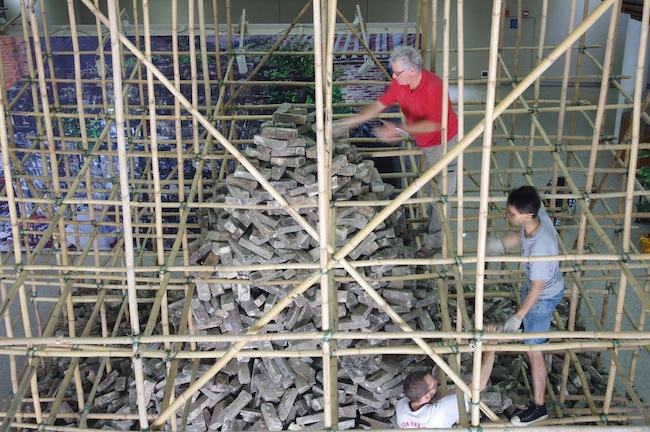In October 2013, French artist Jacques Kaufmann exhibited With One Brick, to Build a World at Zhaoqing University Museum in southern China. The show featured a large brick installation made of about 12,000 bricks supported by a bamboo structure. These two elements reference both the regional landscape and its architecture.
The artist described the work:
“The proposition of installation, like most installations I did in different places in the world, is in relation with the possibilities of the site, and of the country. By possibilities, I mean as well available materials and skills, to realize work with these materials, and the qualities of the space where I will have to do the project.
“It is a long time now that I have been working and visiting China, and through these experiences, born the desire for me to work with bricks and bamboos, at large scale.”
Kaufmann said he prefers not to explain the “meaning” of his works, saying installation should first be a physical feeling within the viewer.
He did, however, include a discussion of his project between Wei Hua, head of the ceramics program at Guangzhou Academy of Fine Arts and Xu Hongbo, head of the ceramics program at the School of Fine Arts, Zhaoqing University, Guangdong Province. A portion of their dialogue follows:
Xu Hongbo: There are many interesting ceramic tile products in Foshan City. The theme of Mr. Kaufmann’s exhibition was bricks which matched the city’s background unexpectedly.
Wei Hua: In fact, the earliest human life has a close relationship to pottery, but the real human intelligence creation is architecture. Brick is the most basic element of architecture, Kaufmann may choose bricks based on that.
Xu: Mr. Kaufman was shocked by the huge brick field at the desert of Rwanda when he was working there in the eighties. He was attracted to this massive brick landscape. And because the tiles and the earth have such a direct or intuitive relationship, it is the part of the roots of human beings. He had a totally different view about brick when he arrived in China.
Xu:… So it may look very simple as a stack of bricks. (Wei: It represents Zen). Kaufmann’s work may not be understood by some Chinese professors; they may think his work is too simple. Perhaps they prefer something more descriptive or easy to grasp in the sense of aesthetic. (Wei: Something mundane). They may think his work had no technical content. I think what Mr. Bai Ming said was right: “Kaufmann is a complex, thinking type, he can’t be simply defined as a ceramic artist.” If he’s judged as a conventional potter, for example, there is no ceramic skills, no ceramic languages, a lot of people would certainly not accept his work.
Wei: It is a little awkward. The real temperament of contemporary ceramic work is not mainstream in China. There is no doubt that it will be meaningless if we put Kaufmann in the scope of a potter and compare him with other potters. He is essentially an artist who is using ceramics as media for his art work. So I still feel the need to think a little more metaphysically, more from the perspective of Chinese and Western cultures and backgrounds. Personally, I think Kaufmann’s works and Chinese literati spiritual qualities are interlinked. It doesn’t matter whether the image is rendered, understated or spiritual; there is no need to have real figure, nothing about narrative, nothing about literature, nothing about decorative. Rather savory go the Zen context instead of discussing whether he is a potter or not.
Above image: Set-up of the brick installation in With One Brick, to Build a World by Jacques Kaufmann. The artist is shown here setting bricks near the peak of the structure. Photograph courtesy of the artist.
Any thoughts about this post? Share yours in the comment box below.
“Moving Mountains,” a stop-motion film documenting Jacques Kaufmann’s brick installation at Zhaoqing University from Garth Clark on Vimeo.
A stop motion film documenting the construction and deconstruction of With One Brick, to Build a World. Video courtesy of the artist.





Process and concept photographs along with the completed brick structure.




These photographs provided by Kaufmann show traditional bamboo building practices in South China, where Zhaoqing is located. These are referenced in Kaufmann’s brick installation.
Kaufmann also included photographs of an island in a lake near Zhaoqing. The artist told CFile, “This surrounding has modified slightly my formal intentions.”


Works on display at With One Brick, to Build a World.


Installation views. All photographs courtesy of Jacques Kaufmann.
Visit Kaufmann at the World Association of Brick Artists

Add your valued opinion to this post.